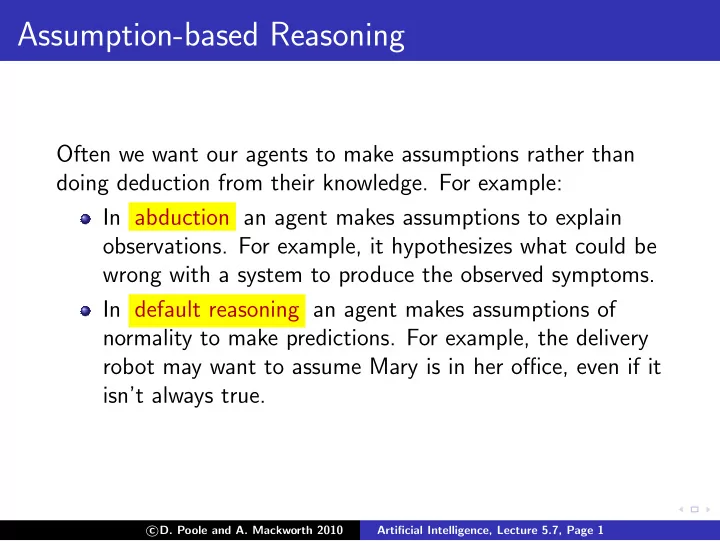

Assumption-based Reasoning Often we want our agents to make assumptions rather than doing deduction from their knowledge. For example: In abduction an agent makes assumptions to explain observations. For example, it hypothesizes what could be wrong with a system to produce the observed symptoms. In default reasoning an agent makes assumptions of normality to make predictions. For example, the delivery robot may want to assume Mary is in her office, even if it isn’t always true. � D. Poole and A. Mackworth 2010 c Artificial Intelligence, Lecture 5.7, Page 1
Design and Recognition Two different tasks use assumption-based reasoning: Design The aim is to design an artifact or plan. The designer can select whichever design they like that satisfies the design criteria. Recognition The aim is to find out what is true based on observations. If there are a number of possibilities, the recognizer can’t select the one they like best. The underlying reality is fixed; the aim is to find out what it is. Compare: Recognizing a disease with designing a treatment. Designing a meeting time with determining when it is. � D. Poole and A. Mackworth 2010 c Artificial Intelligence, Lecture 5.7, Page 2
The Assumption-based Framework The assumption-based framework is defined in terms of two sets of formulae: F is a set of closed formula called the facts . These are formulae that are given as true in the world. We assume F are Horn clauses. H is a set of formulae called the possible hypotheses or assumables. Ground instance of the possible hypotheses can be assumed if consistent. � D. Poole and A. Mackworth 2010 c Artificial Intelligence, Lecture 5.7, Page 3
Making Assumptions A scenario of � F , H � is a set D of ground instances of elements of H such that F ∪ D is satisfiable. An explanation of g from � F , H � is a scenario that, together with F , implies g . D is an explanation of g if F ∪ D | = g and F ∪ D �| = false . A minimal explanation is an explanation such that no strict subset is also an explanation. An extension of � F , H � is the set of logical consequences of F and a maximal scenario of � F , H � . � D. Poole and A. Mackworth 2010 c Artificial Intelligence, Lecture 5.7, Page 4
Example a ← b ∧ c . { e , m , n } is a scenario. b ← e . { e , g , m } is not a scenario. b ← h . { h , m } is an explanation for a . c ← g . { e , h , m } is an explanation for a . c ← f . { e , g , h , m } isn’t an explanation. d ← g . false ← e ∧ d . { e , h , m , n } is a maximal scenario. f ← h ∧ m . { h , g , m , n } is a maximal scenario. assumable e , h , g , m , n . � D. Poole and A. Mackworth 2010 c Artificial Intelligence, Lecture 5.7, Page 5
Default Reasoning and Abduction There are two strategies for using the assumption-based framework: Default reasoning Where the truth of g is unknown and is to be determined. An explanation for g corresponds to an argument for g . Abduction Where g is given, and we are interested in explaining it. g could be an observation in a recognition task or a design goal in a design task. Give observations, we typically do abduction, then default reasoning to find consequences. � D. Poole and A. Mackworth 2010 c Artificial Intelligence, Lecture 5.7, Page 6
Computing Explanations To find assumables to imply the query ? q 1 ∧ . . . ∧ q k : ac := “ yes ← q 1 ∧ . . . ∧ q k ” repeat select non-assumable atom a i from the body of ac ; choose clause C from KB with a i as head; replace a i in the body of ac by the body of C until all atoms in the body of ac are assumable. To find an explanation of query ? q 1 ∧ . . . ∧ q k : find assumables to imply ? q 1 ∧ . . . ∧ q k ensure that no subset of the assumables found implies false � D. Poole and A. Mackworth 2010 c Artificial Intelligence, Lecture 5.7, Page 7
Recommend
More recommend